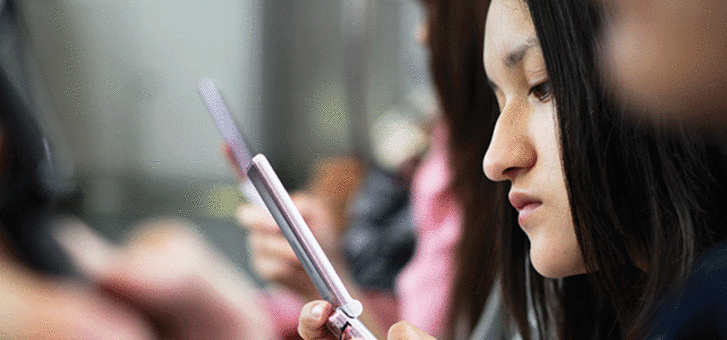It is lunchtime at a typical high school. A few Year 11 boys spread out to kick a ball around, call out good-natured insults to each other and devour sandwiches as quick as inhaling.
She’s skipped school, and in her bedroom, a 13-year-old girl is trying different naked and semi-naked poses in front of her mirror. She wants to send a sexy image to her boyfriend but can’t decide which pose; whether to send through the Snapchat app—which means the photo would dissolve after a few seconds—or in a downloadable form; or if she should send video instead of a photo.
Back at school, a boy reaches into his pocket to retrieve his phone, which had alerted him that he had received a new text message. He clicks on an icon on the screen and the sudden brightness from an image reflects on his face. He emits a shock of laughter and after a moment, holds the phone out for his friends, who circle the device. Just seconds after the image was first clicked on, it dissolves into nothing.
Sharing provocative, near-nude images—personalised pornography—has become a huge part of the teenage social and dating scene. A 2010 study found that 59 per cent of Australian teenagers had sent sexually-suggestive text messages or emails. An American survey in the same year discovered that nearly one in six teens between the ages of 12 and 17 who owned mobile phones had received nude or near-nude pictures via text message from a person they knew.
“Sexting” incidents—sending sexually explicit messages or photographs, primarily between mobile phones—have skyrocketed in recent times due to new devices and smartphone applications, coupled with the ideology among teenagers that viewing and sending such images is common and therefore acceptable behaviour.
As a result, homegrown, underage pornography regularly does the rounds of middle- and high-schools around the world and the majority of teenagers have sent, received or viewed related images.
And while such sexualised photos and videos are usually exchanged with the intention of being viewed by a single recipient, they are in fact frequently shared with other individuals. And it doesn’t stop there.
These intensely private images can set out on a long journey, visiting various viewing platforms and public arenas along the way. This includes one or both parties showing the image to friends, posting it in a private Facebook message to acquaintances, sending an email to multiple audiences and even uploading it to a website frequented by paedophiles and porn users. Such websites are full of leaked sexts (mostly of young girls visibly still in their teens), some of which can even be rated by viewers according to “entertainment” value.
For 18-year-old “Melissa,” live video chatting ended in further rights violations. At 15, she became involved in sexting with someone she trusted. Soon, however, he threatened to reveal the sexts if she didn’t provide him with more “entertainment.”
Explicit video chatting followed and “some weeks later, I heard from one of his mates. Apparently my ‘friend’ had told him all about the deal he and I had going, and his friend wanted to get in on the action too. It then turned out that I had two boys to keep occupied.”
Lawmakers are reluctant to charge teens who consensually share nude photographs. However, if cases involve deception, schoolyard trading of illicit images and blackmail, perpetrators can be charged under child-exploitation laws.
Commentators say that the problem is tricky because of the ease of access and constant availability of pornography and sexual images which affects the behaviour and expectations of teens.
Significantly, the roles of actor, groomer, producer and distributor, usually kept separate in the adult pornography industry, regularly overlap in this demographic so that lines are blurred. Ironically, underage teens can be both victims of child sexual abuse and perpetrators.
“Chaplains and teachers are hearing some of the stories, so you can be sure there’s much more going on,” says school chaplain Cameron Hooper. “The problem with sexting is that it encourages the hiding of sex so that it becomes a bigger monster in the cupboard.”
Hooper explains that this issue is not a simple narrative of the bad boy and damsel in distress. “Boys and girls are both victims of this culture because it changes their understanding of sex and relationships. You can’t separate the physical from the mind and spirit of a person. Society tries to separate it and says ‘get sex at all costs because it feels good’ but the Bible says that sexual immorality has an impact on your entire being.”
Certainly, modern devices add a complex twist to the difficult terrain of pornography and sex, and parents can’t afford to be complacent about the potentially devastating ramifications. Ongoing open dialogue in a family setting will give teens a chance to form opinions and consider their boundaries outside of group conformity.
Snapchat
The photo-messaging smartphone app Snapchat, with a majority demo- graphic of 13- to 23-year- olds, has been blamed for creating an increase in demand for sexualised images between teens.
The app allows users to take a “snap” and send it as a view-once, dissolvable image within a selected timeframe of no more than 10 seconds. The appeal is that users can be more spontaneous and candid, and because they believe that their image will remain private, hidden and temporary, the more risk-averse teen is more likely to consider sexting.
However, it is possible to screenshot a Snapchat image, and this may then be uploaded to public websites or other viewing platforms, making such photos somewhat less than temporary.






